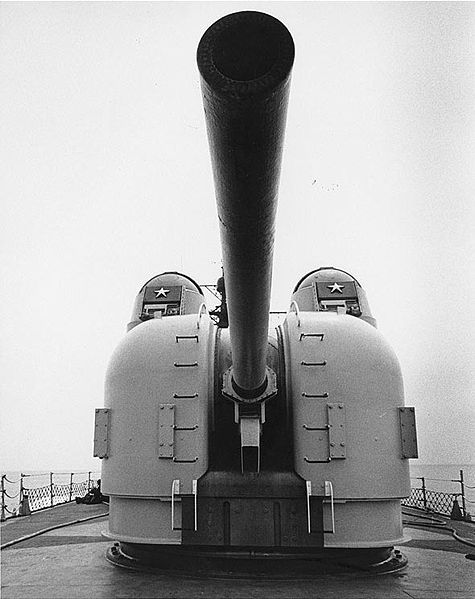5-inch/54-caliber Mark 42 gun
The Mark 42 5"/54 caliber gun (127mm) is a naval gun mount used by the United States Navy and other countries. It consisted of the Mark 18 gun and Mark 42 gun mount. United States naval gun terminology indicates the gun fires a projectile 5 inches (127.0 mm) in diameter, and the barrel is 54 calibers long In the 1950s a gun with more range and a faster rate of fire than the 5"/38 caliber gun used in World War II was needed, therefore, the gun was created concurrently with the 3"/70 Mark 26 gun for different usages. The 5"/54 Mk 42 is an automatic, dual-purpose gun mount. It is usually controlled remotely from the Mk 68 Gun Fire Control System, or locally from the mount at the One Man Control (OMC) station.
5 inch/54 Mark 42 on USS Turner Joy
Two of the eight turrets of the carrier USS Ranger firing, in 1961.
Side profile of the 5-inch gun from HMAS Brisbane
The Mark 12 5"/38 caliber gun was a United States dual-purpose naval gun, but also installed in single-purpose mounts on a handful of ships. The 38 caliber barrel was a mid-length compromise between the previous United States standard 5"/51 low-angle gun and 5"/25 anti-aircraft gun. United States naval gun terminology indicates the gun fired a projectile 5 inches (127 mm) in diameter, and the barrel was 38 calibers long. The increased barrel length provided greatly improved performance in both anti-aircraft and anti-surface roles compared to the 5"/25 gun. However, except for the barrel length and the use of semi-fixed ammunition, the 5"/38 gun was derived from the 5"/25 gun. Both weapons had power ramming, which enabled rapid fire at high angles against aircraft. The 5"/38 entered service on USS Farragut, commissioned in 1934, the first new destroyer design since the last Clemson was built in 1922. The base ring mount, which improved the effective rate of fire, entered service on USS Porter, commissioned in 1936.

Two Mk 30 single enclosed base ring mounts on USS David W. Taylor
Mk 12 gun assembly
Vertical Sliding Wedge Breech Block.
Drawing of the recoil and counter-recoil systems. The arrow shows the motion of the housing in the slide during recoil.







